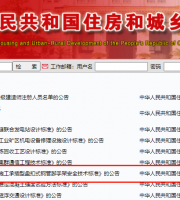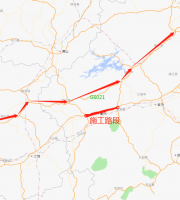Waterproofing membrane is mainly used in building walls, roofs, tunnels, highways and other places
. 
It is a flexible building material product that can be curled into rolls to resist external rainwater and groundwater leakage
.
As a non leakage connection between the engineering foundation and buildings, it is the first barrier for the whole project waterproofing and plays a vital role in the whole project
.
The main products are asphalt waterproofing membrane and polymer waterproofing membrane
.
This paper introduces the construction method and precautions of waterproof membrane in detail
.
1
.
Requirements for base surface: the base surface shall be cleaned, the moisture content shall not be more than 9%, and it shall be smooth and dense, and the ends of each node shall be neat and complete, meeting the requirements
.
2
.
The first waterproof layer: (1) lay flexible waterproof layer, choose coating or coiled material
.
Its construction conditions require that the moisture content of the base surface should not be greater than 9%, so it is suitable for construction in summer after hot weather and continuous fine weather for 5 days
.
After completion, water storage test should be done
.
(2) In case of waterproof coating, take “one cloth and two coats” as an example: after cleaning the base course, apply one coat of coating, after drying to form a film, lay a layer of glass fiber cloth matrix reinforcement material, and apply one coat of coating on the flattened surface for fixation, and then carry out the next coat of coating construction after drying
.
The total thickness of waterproof coating shall be more than 3mm
.
(3) For example, in the construction of waterproof coiled material, after cleaning the base course, brush adhesive on the reverse side of the coiled material and the base course, paste and roll from far to near according to the snapping datum line, and finally check the joint end
.
3
.
The second waterproof layer: the rigid waterproof layer shall be laid about two days after the completion of the first flexible waterproof layer
.
The basic materials are high-grade fatty acid mortar waterproof agent, cement, sand, fine aggregate and fiber
.
The thickness of the waterproof layer shall be 20-30mm
.
(1) According to the requirements of the specification, install the partition wood strip, and the partition setting is 4000 mm × 4000 mm
.
Then spray water to make the base surface moist, but there shall be no ponding
.
(2) According to the order from far to near and from high to low, the prepared mortar or fine aggregate concrete shall be constructed one by one, and the same division shall be completed at one time, and then leveled and compacted
.
(3) After initial setting, take out the dividing wood strip, press and polish and trim the dividing joint
.
(4) The flexible sealing material is used to fill the dividing seam, and the surface is closed
.
Pay attention to watering maintenance after construction
.
(5) If there is planting soil on the roof, it should be covered with planting soil as soon as possible
.
1
.
The roof engineering is a part of the construction engineering, which refers to the construction content of the roof surface, including the waterproof engineering and the heat insulation engineering of the roof
.
It is composed of roof leveling layer, gas barrier layer, thermal insulation layer, waterproof layer, protective layer or use surface layer above the structural layer
.
The quality of its construction will directly affect the service life of buildings
.
2
.
According to its form, roof can be divided into flat roof, sloping roof and special-shaped roof; according to its use function, roof can be divided into non accessible roof and accessible roof; according to its heat insulation function, roof can be divided into heat insulation roof and non heat insulation roof
.
3
.
Roof waterproof engineering can be divided into rigid waterproof roof and flexible waterproof roof according to different waterproof materials
.
Rigid waterproof roof refers to the roof which is waterproof by pouring waterproof concrete, applying waterproof mortar or laying sintered flat tile and cement flat tile; flexible waterproof roof refers to the roof which is waterproof by laying waterproof coiled material, linoleum tile and brushing waterproof paint
.
According to the different waterproof materials used in the waterproof layer, the roof can be divided into rigid concrete waterproof roof, flat tile roof, coiled material waterproof roof, film waterproof roof, linoleum tile waterproof roof, metal plate waterproof roof, etc
.
4
.
Precautions for roof waterproof construction: 1) it is strictly forbidden to carry out coiled material and thermal insulation construction in rainy days
.
2) The leveling layer of membrane waterproof layer shall meet the quality requirements and reach the specified degree of dryness
.
3) In the corner of the roof, gutter, gutter, ridge, lap joint of coiled material, end joint and other joint parts, it is necessary to carefully pave, paste, compact, end firmly, meet the design requirements and roof engineering technical specifications and other relevant provisions
.
In the corner of the roof, gutter, gutter, ridge and other parts, it is necessary to pave additional layer of coiled material
.
4) When paving coiled materials, excessive tension and wrinkling shall be avoided
.
The air exhaust between the base course and coiled materials shall be sufficient
.
After the air exhaust to both sides of the horizontal direction, the rolls shall be used to flatten and paste
.
5) The lap width and paving of coiled materials shall be straight, and the construction shall be carried out in strict accordance with the marking line of the base course
.
6) When laying the insulation layer, the waterproof layer should be well protected
.
Waterproof engineering is an important project of housing construction
.
The quality of engineering is related to the service life of buildings, and also directly affects the normal production activities and life of people
.
According to statistics, the causes of roof leakage are as follows: materials account for 20% ~ 22%, design for 18% ~ 26%, construction for 45% ~ 48%, management and maintenance for 6% ~ 15%
.
At present, there are many new materials for roof waterproofing, but the membrane waterproofing layer still occupies an important position, so this paper focuses on the construction of roof membrane waterproofing
.
Before the construction of roofing membrane waterproofing, the following work should be done: 1
.
Technical preparation before construction
.
Before the construction of roofing engineering, the construction unit should organize technical management personnel to review the roofing engineering drawings, master the detailed structure and relevant technical requirements in the construction drawings, and prepare the construction scheme or technical measures of roofing engineering according to the actual situation of the project
.
In this way, defects will be avoided after construction, resulting in rework
.
At the same time, the project will be carried out in a planned way according to the construction organization, so as to prevent work omission, confusion and reversal, which will affect the project quality
.
With the construction organization, the person in charge of the next construction should make technical disclosure to the team
.
The contents include: construction position, construction sequence, construction technology, structure level, node fortification method, reinforcement position and method, engineering quality standard, technical measures to ensure quality, protection measures and safety precautions of finished products
.
2、 According to the requirements of construction personnel and construction procedures, the waterproof construction of roof engineering must be carried out by professional waterproof team or waterproof worker
.
It is strictly forbidden for units without qualification grade certificate and non waterproof professional team or non waterproof worker to carry out waterproof construction of roof engineering
.
The construction unit or supervision company shall seriously check the work license of construction personnel
.
During the construction, the construction unit shall carry out quality self inspection, self inspection and self correction according to the construction process and level, and make good construction records
.
The supervision unit shall do a good job in the acceptance of each process, and the next process and level operation can be carried out only after the acceptance is qualified
.
3、 For the quality requirements of waterproof materials, the waterproof materials used in roof engineering shall be provided with material quality certification documents and certified by the designated quality inspection department to ensure that their quality meets the requirements of technical code for roof engineering (GB 50207-94) or relevant national standards
.
After entering the construction site, waterproof materials shall be attached with factory inspection report and factory certificate, and marked with production date, batch number, specification and name
.
The construction unit shall take samples for re inspection according to the regulations
.
The sampling and re inspection shall be conducted in strict accordance with the witness sampling system
.
Under the witness of the representative of the construction unit or the personnel of the supervision unit, the construction personnel shall take samples on site and send them to the laboratory for test
.
It can be used in waterproof engineering only after the re inspection is qualified and the re inspection test report is submitted
.
It is strictly forbidden to use unqualified waterproof materials in the project
.
Once unqualified materials are found, they should be immediately evacuated from the construction site
.
Key points of roof waterproof construction: 1
.
Environmental requirements of Construction: in order to ensure the construction operation and the quality of coil paving, it is suitable to construct at + 50c to + 350C temperature; polymer modified asphalt and polymer waterproof coil should not be constructed below negative temperature; hot melt paving coil can be constructed at above-100c temperature, which is resistant to low temperature and not easy to be frozen under negative temperature
.
Rain, snow, frost, fog, or excessive atmospheric humidity, and windy weather are not suitable for open-air operation, otherwise corresponding technical measures should be taken.
.




